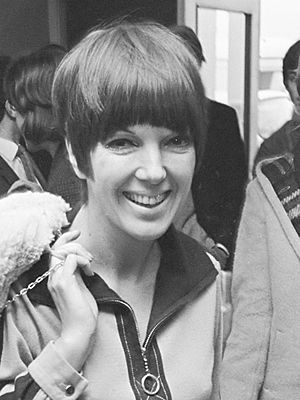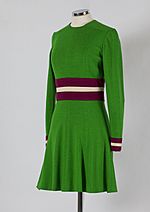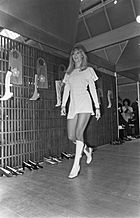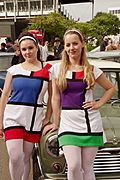Mary Quant facts for kids
Quick facts for kids
Mary Quant
|
|
|---|---|

Quant in 1966
|
|
| Born |
Barbara Mary Quant
11 February 1930 Blackheath, London, England
|
| Died | 13 April 2023 (aged 93) Surrey, England
|
| Other names | Barbara Mary Plunket Greene |
| Education | Goldsmiths College |
|
Label(s)
|
Mary Quant |
| Spouse(s) |
Alexander Plunket Greene
(m. 1957; died 1990) |
| Children | 1 |
| Awards | CH, DBE, FCSD, RDI |
Dame Mary Quant (born Barbara Mary Quant; 11 February 1930 – 13 April 2023) was a famous British fashion designer. She was a key figure in the 1960s London fashion scene, especially with the Mod and youth movements. She is known for helping to make the miniskirt and hotpants popular. Fashion writer Ernestine Carter once said that only a few people are born at the right time with the right talents, and she named Chanel, Dior, and Mary Quant as examples in fashion.
Contents
Early Life and Education
Mary Quant was born on 11 February 1930, in Blackheath, London. Her parents, Jack and Mildred Quant, were both teachers from Wales. They had studied at Cardiff University before moving to London.
Mary went to Blackheath High School. She really wanted to study fashion in college. However, her parents encouraged her to study something else. So, she studied illustration and art education at Goldsmiths College, finishing her degree in 1953. After college, she followed her love for fashion by working as an apprentice for a fancy hat maker in Mayfair, London.
Starting a Fashion Revolution
Mary Quant first started selling clothes she bought from other companies in her new shop, called Bazaar. Soon, the more daring and unique clothes she had started to get noticed by fashion magazines like Harper's Bazaar. An American company even bought some of her dress designs. Because of this attention, and because she loved these bold styles, she decided to design clothes herself.
At first, she worked alone, but soon she hired people to help her sew. By 1966, she was working with 18 different manufacturers! Mary taught herself how to design. She was inspired by the trendy "Chelsea Set" of artists and socialites in London. Her designs were much more daring and unique than the usual styles of the time. Mary Quant's designs completely changed fashion. They moved away from the serious, practical styles of the late 1940s to the energetic, new looks of the 1950s and 1960s. She filled her shop with her own colorful and patterned items, like bright tights.
The Bazaar Boutique
Mary Quant's influence wasn't just from her designs. In her shop, Bazaar, she created a special atmosphere. There was music, drinks, and the shop stayed open for long hours. This made it very appealing to young people. This kind of shopping experience was new for the fashion world. It was very different from the boring department stores or the super fancy designer shops that were common back then.
Her shop windows were also very eye-catching. She used models in funny and quirky poses, which made many people stop and stare. She said that within just ten days of opening, almost all of her original clothes were sold out!
For a while in the late 1950s and early 1960s, Mary Quant was one of only two top designers in London who consistently made youthful clothes for young people. The other designer was Kiki Byrne, who opened her shop on the King's Road right near Quant's. In 1966, Mary Quant was named one of the "fashion revolutionaries" in New York by Women's Wear Daily.
The Miniskirt and Beyond
The miniskirt is one of the most famous fashion items of the 1960s, and it's strongly connected to Mary Quant. Many people say she invented it, but others disagree. Some say another British designer, John Bates, or even French designer André Courrèges, created it first. However, skirts had been getting shorter since the 1950s. Mary Quant saw this as a practical and freeing change, allowing women to move easily and even run for a bus!
Mary Quant later explained that the girls on the King's Road in London, during the "Swinging London" era, were the ones who truly inspired the miniskirt. She said, "I was making easy, youthful, simple clothes, in which you could move, in which you could run and jump and we would make them the length the customer wanted. I wore them very short and the customers would say, 'Shorter, shorter.'" She named the miniskirt after her favorite car, the Mini. She described the women who wore them as "curiously feminine, but their femininity lies in their attitude rather than in their appearance... She enjoys being noticed, but wittily. She is lively—positive—opinionated." The famous fashion model Twiggy helped make the miniskirt popular around the world.
Besides the miniskirt, Mary Quant is also often given credit for inventing the colorful and patterned tights that often went with the miniskirt. However, others say the Spanish designer Cristóbal Balenciaga or John Bates might have created them first.
Later Career and Legacy
In the late 1960s, Mary Quant also introduced very short shorts, which were an early version of hotpants. She continued to be a British fashion icon. In 1967, she designed berets in twelve colors for the British company Kangol. These berets, with her famous daisy logo, are now part of her collection at the Victoria and Albert Museum.
Through the 1970s and 1980s, she focused more on household items and make-up, not just clothes. She even claimed to have invented the duvet (a type of comforter).
In 1988, Mary Quant designed the inside of a special edition Mini car, called the Mini Designer. It had black-and-white striped seats with red trim, red seatbelts, and her signature on the seats and steering wheel. The car also featured her daisy logo. Two thousand of these cars were released in the UK.
In 2000, she stepped down as a director of Mary Quant Ltd, her cosmetics company, after it was bought by a Japanese company. Today, there are over 200 Mary Quant Colour shops in Japan.
Personal Life and Honours
Mary Quant met her future husband and business partner, Alexander Plunket Greene, in 1953. They were married in 1957 and stayed together until his death in 1990. They had one son, Orlando, who was born in 1969.
Mary Quant passed away at her home in Surrey, England, on 13 April 2023, at the age of 93.
Awards and Recognition
"She was the godmother of the youth movement in fashion, the first to realise that how women dressed needed to change."
Mary Quant received many important awards for her work in fashion. In 1963, she won the first-ever Dress of the Year award. In 1966, she was made an Officer of the Order of the British Empire (OBE) for her amazing contributions to fashion. She even went to Buckingham Palace to accept the award wearing a cream minidress!
In 1990, she won the Hall of Fame Award from the British Fashion Council. She was later made a Dame Commander of the Order of the British Empire (DBE) in 2015 and a Member of the Order of the Companions of Honour (CH) in 2023.
In 2006, she received an honorary degree from Heriot-Watt University. In 2009, the miniskirt she designed was chosen by the Royal Mail to be featured on a special "British Design Classics" postage stamp. In 2012, she was also chosen by artist Sir Peter Blake to appear in a new version of his famous artwork, the Beatles' Sgt. Pepper's Lonely Hearts Club Band album cover.
Mary Quant was also a fellow of the Chartered Society of Designers and won their highest award, the Minerva Medal.
See also
 In Spanish: Mary Quant para niños
In Spanish: Mary Quant para niños
- Daisy, a doll designed by Quant





